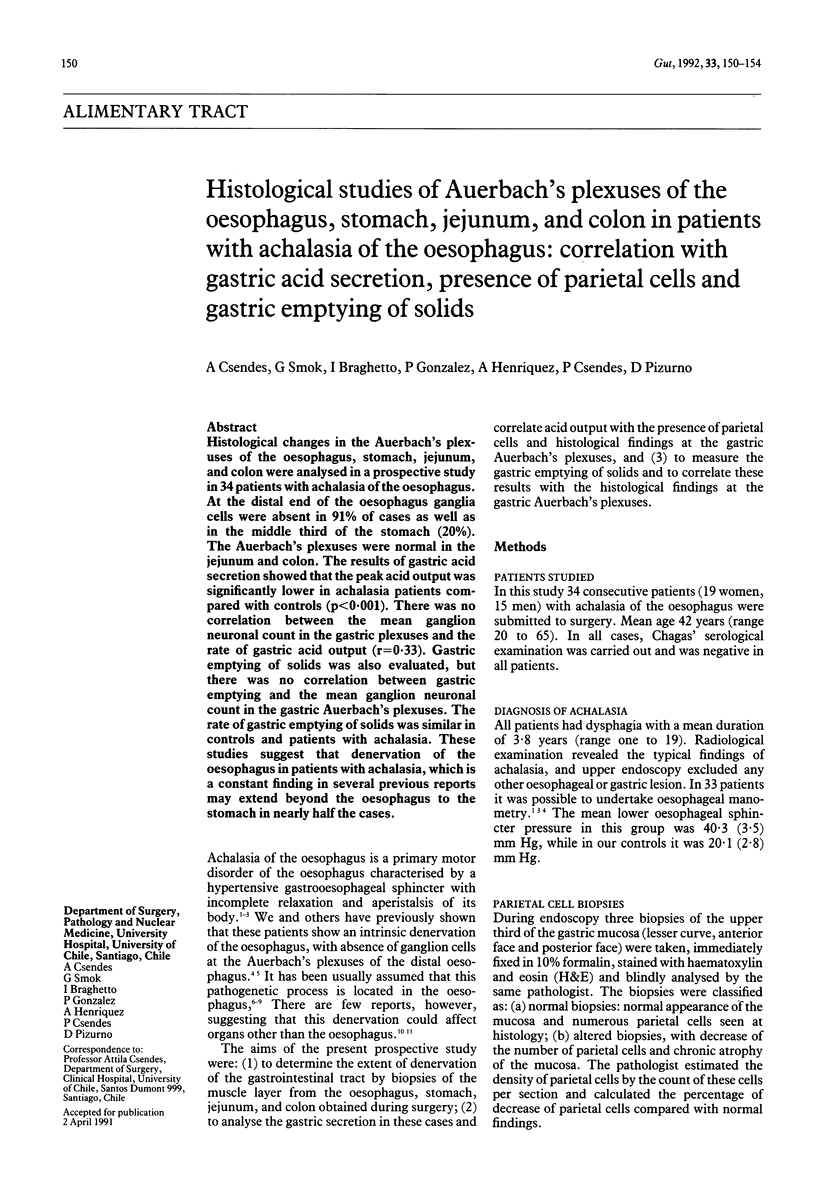Abstract
Histological changes in the Auerbach's plexuses of the oesophagus, stomach, jejunum, and colon were analysed in a prospective study in 34 patients with achalasia of the oesophagus. At the distal end of the oesophagus ganglia cells were absent in 91% of cases as well as in the middle third of the stomach (20%). The Auerbach's plexuses were normal in the jejunum and colon. The results of gastric acid secretion showed that the peak acid output was significantly lower in achalasia patients compared with controls (p less than 0.001). There was no correlation between the mean ganglion neuronal count in the gastric plexuses and the rate of gastric acid output (r = 0.33). Gastric emptying of solids was also evaluated, but there was no correlation between gastric emptying and the mean ganglion neuronal count in the gastric Auerbach's plexuses. The rate of gastric emptying of solids was similar in controls and patients with achalasia. These studies suggest that denervation of the oesophagus in patients with achalasia, which is a constant finding in several previous reports may extend beyond the oesophagus to the stomach in nearly half the cases.
Full text
PDF




Selected References
These references are in PubMed. This may not be the complete list of references from this article.
- Aggestrup S., Uddman R., Jensen S. L., Sundler F., Schaffalitzky de Muckadell O., Holst J. J., Håkanson R., Ekman R., Sørensen H. R. Regulatory peptides in the lower esophageal sphincter of man. Regul Pept. 1985 Mar;10(2-3):167–178. doi: 10.1016/0167-0115(85)90011-4. [DOI] [PubMed] [Google Scholar]
- Aggestrup S., Uddman R., Sundler F., Fahrenkrug J., Håkanson R., Sørensen H. R., Hambraeus G. Lack of vasoactive intestinal polypeptide nerves in esophageal achalasia. Gastroenterology. 1983 May;84(5 Pt 1):924–927. [PubMed] [Google Scholar]
- Atkinson M., Ogilvie A. L., Robertson C. S., Smart H. L. Vagal function in achalasia of the cardia. Q J Med. 1987 Apr;63(240):297–303. [PubMed] [Google Scholar]
- CASSELLA R. R., BROWN A. L., Jr, SAYRE G. P., ELLIS F. H., Jr ACHALASIA OF THE ESOPHAGUS: PATHOLOGIC AND ETIOLOGIC CONSIDERATIONS. Ann Surg. 1964 Sep;160:474–487. doi: 10.1097/00000658-196409000-00010. [DOI] [PMC free article] [PubMed] [Google Scholar]
- Castell D. O. Achalasia and diffuse esophageal spasm. Arch Intern Med. 1976 May;136(5):571–579. [PubMed] [Google Scholar]
- Christensen J., Rick G. A., Robison B. A., Stiles M. J., Wix M. A. Arrangement of the myenteric plexus throughout the gastrointestinal tract of the opossum. Gastroenterology. 1983 Oct;85(4):890–899. [PubMed] [Google Scholar]
- Christensen J., Robison B. A. Anatomy of the myenteric plexus of the opossum esophagus. Gastroenterology. 1982 Nov;83(5):1033–1042. [PubMed] [Google Scholar]
- Collins P. J., Horowitz M., Cook D. J., Harding P. E., Shearman D. J. Gastric emptying in normal subjects--a reproducible technique using a single scintillation camera and computer system. Gut. 1983 Dec;24(12):1117–1125. doi: 10.1136/gut.24.12.1117. [DOI] [PMC free article] [PubMed] [Google Scholar]
- Csendes A., Ornsholt J., Venturelli A., Henriquez A. Dose-response studies of acid secretion after administration of tetragastrin. Studies in duodenal ulcer patients before and after highly selective vagotomy, hemigastrectomy and truncal vagotomy plus antrectomy. Am J Surg. 1980 Jun;139(6):832–837. doi: 10.1016/0002-9610(80)90392-x. [DOI] [PubMed] [Google Scholar]
- Csendes A., Smok G., Braghetto I., Ramirez C., Velasco N., Henriquez A. Gastroesophageal sphincter pressure and histological changes in distal esophagus in patients with achalasia of the esophagus. Dig Dis Sci. 1985 Oct;30(10):941–945. doi: 10.1007/BF01308293. [DOI] [PubMed] [Google Scholar]
- Csendes A., Velasco N., Braghetto I., Henriquez A. A prospective randomized study comparing forceful dilatation and esophagomyotomy in patients with achalasia of the esophagus. Gastroenterology. 1981 Apr;80(4):789–795. [PubMed] [Google Scholar]
- Dooley C. P., Taylor I. L., Valenzuela J. E. Impaired acid secretion and pancreatic polypeptide release in some patients with achalasia. Gastroenterology. 1983 Apr;84(4):809–813. [PubMed] [Google Scholar]
- Eckardt V. F., Krause J., Bolle D. Gastrointestinal transit and gastric acid secretion in patients with achalasia. Dig Dis Sci. 1989 May;34(5):665–671. doi: 10.1007/BF01540335. [DOI] [PubMed] [Google Scholar]
- Elder J. B., Gillespie G. The vagus and achalasia. Gut. 1969 Dec;10(12):1045–1045. [PubMed] [Google Scholar]
- Faussone-Pellegrini M. S., Cortesini C. The muscle coat of the lower esophageal sphincter in patients with achalasia and hypertensive sphincter. An electron microscopic study. J Submicrosc Cytol. 1985 Oct;17(4):673–685. [PubMed] [Google Scholar]
- Friesen D. L., Henderson R. D., Hanna W. Ultrastructure of the esophageal muscle in achalasia and diffuse esophageal spasm. Am J Clin Pathol. 1983 Mar;79(3):319–325. doi: 10.1093/ajcp/79.3.319. [DOI] [PubMed] [Google Scholar]
- Kumar D., Phillips S. F. Human myenteric plexus: confirmation of unfamiliar structures in adults and neonates. Gastroenterology. 1989 Apr;96(4):1021–1028. doi: 10.1016/0016-5085(89)91619-3. [DOI] [PubMed] [Google Scholar]
- Meyer J. H., VanDeventer G., Graham L. S., Thomson J., Thomasson D. Error and corrections with scintigraphic measurement of gastric emptying of solid foods. J Nucl Med. 1983 Mar;24(3):197–203. [PubMed] [Google Scholar]
- Misiewicz J. J., Waller S. L., Anthony P. P., Gummer J. W. Achalasia of the cardia: pharmacology and histopathology of isolated cardiac sphincteric muscle from patients with and without achalasia. Q J Med. 1969 Jan;38(149):17–30. [PubMed] [Google Scholar]
- Padovan W., Meneghelli U. G., Alves de Godoy R. Gastric secretory and motility studies in chronic chagasic patients. Am J Dig Dis. 1977 Jul;22(7):618–622. doi: 10.1007/BF01073080. [DOI] [PubMed] [Google Scholar]
- Qualman S. J., Haupt H. M., Yang P., Hamilton S. R. Esophageal Lewy bodies associated with ganglion cell loss in achalasia. Similarity to Parkinson's disease. Gastroenterology. 1984 Oct;87(4):848–856. [PubMed] [Google Scholar]
- Shih W. J., Domstad P. A., DeLand F. H. Technetium-99m triethylene tetramine polystyrene resin gastric emptying studies in patients with various upper gastrointestinal diseases. Clin Nucl Med. 1985 Jul;10(7):494–497. doi: 10.1097/00003072-198507000-00011. [DOI] [PubMed] [Google Scholar]
- Uribe P., Jr, Csendes A., Larrain A., Ayala M. Motility studies in fifty patients with achalasia of the esophagus. Am J Gastroenterol. 1974 Oct;62(4):333–336. [PubMed] [Google Scholar]


